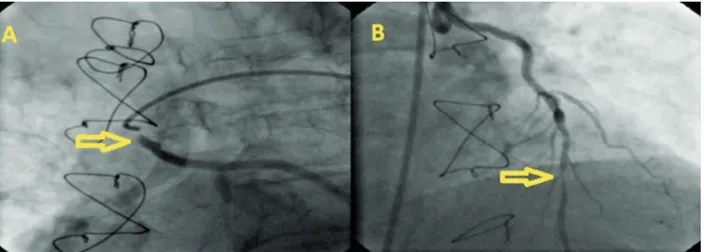Katlandur et al. Reoperaive coronary artery bypass grating 380
J Clin Exp Invest www.jceionline.org Vol 4, No 3, September 2013
1 Cardiology Department of Mevlana (Rumi) Medical School, Konya, Turkey 2 Cardiology Department of Konya Numune State Hospital, Konya, Turkey
Correspondence: Zeynein Kaya,
Cardiology Department of Mevlana (Rumi) Medical School, Konya, Turkey Email: zeyneinkaya@yahoo.com Received: 05.05.2013, Accepted: 20.05.2013
Copyright © JCEI / Journal of Clinical and Experimental Invesigaions 2013, All rights reserved
JCEI / 2013; 4 (3): 380-382
Journal of Clinical and Experimental Invesigaions doi: 10.5799/ahinjs.01.2013.03.0308 C A S E R E P O RT / O LG U S U N U M U
Reoperaive coronary artery bypass grating
Koroner arter bypass gretlemesi yeniden operasyonu
Hüseyin Katlandur1, Şeref Ulucan1, Ahmet Keser1, Zeynein Kaya1, Abdullah Tuncez2
ÖZET
Koroner arter bypass greftlemesi yeniden operasyonu %11,4’e varan oranlarda yüksek mortalite ile birliktedir. Koroner arter bypass greftleme (KABG) operasyonu ge-çiren hastaların %10-20’sinin 10 yıl içinde yeniden KABG operasyonuna ihtiyaç duyacakları tahmin edilmektedir. Yüksek ameliyat riskleri nedeniyle KABG öyküsü olan ve akut koroner sendromu ile gelen hastalar için perkutan koroner girişimler önerilen tedavi yöntemi olarak ortaya çıkmıştır. Burada yeniden KABG operasyonu ihtiyacı do -ğan bir hastada uyguladığımız perkutan koroner girişimi sunduk.
Anahtar kelimeler: Akut koroner sendrom, yeniden KABG operasyonu, perkutan koroner girişim
ABSTRACT
Reoperative coronary artery bypass grafting (redo CABG) operation is associated with a high rate of mortality up to 11.4%. It has been estimated that 10-20% of patients with history of coronary artery bypass grafting (CABG) opera-tion need redo CABG operaopera-tion within 10 years. Due to high operation risk percutaneous coronary interventions have emerged as the preferred treatment for the patients with a history of CABG operation and presenting with acute coronary syndrome. Here, we reported percutane-ous coronary intervention in a patient needed redo CABG operation. J Clin Exp Invest 2013; 4 (3): 380-382
Key words: Acute coronary syndrome, redo CABG op-eration, percutaneous coronary intervention.
INTRODUCTION
Reoperative coronary artery bypass grafting (redo CABG) operation is associated with a high rate of mortality up to 11.4% [1]. It has been estimated that
10-20% of patients with history of CABG operation need redo CABG operation within 10 years [2,3].
AWESOME study showed percutaneous coronary intervention (PCI) is preferable to redo CABG op-eration in patients who had medically refractory
myocardial ischemia [4]. Due to high operation risk
PCI have emerged as the preferred treatment for the patients with a history of CABG operation and presenting with acute coronary syndrome [5].
CASE
A 72-year-old man admitted to emergency depart
-ment with complaint of typical chest pain and dys-pnea. The patient had a history of CABG operation
ifteen years ago. Two saphenous vein grafts (SVG)
were anastomosed to the posterior descending ar-tery and the obtuse marginal branch of the
circum-lex (Cx) artery. The left internal mammary artery
(LIMA) was anastomosed distally to the left anterior
descending artery (LAD). The resting 12-lead elec
-trocardiogram (ECG) showed anterior ischemia. The patient was transferred to the catheter lab after prescription of loading dose of clopidogrel, aspirin and intravenous unfractionated heparin. Coronary
angiography performed and showed LAD occlusion after the site of anastomosis, Cx artery occlusion
after the obtuse marginal branch and the right cor-onary artery (RCA) occlusion in the mid segment.
The SVG of the posterior descending artery was occluded in the proximal segment and the SVG of
the obtuse marginal branch occluded 95% in ostial segment of aortic anastomosis (Figure 1A). LIMA
graft was open but the distal LAD segment occlud
-ed 90% (Figure 1B). The patient had ongoing chest
pain and coronary lesions thought to be suitable for percutaneous transluminal coronary angioplasty. We decided to perform on-site PCI to the
anasto-mosis of the SVG lesion. A 6-Fr Judkins right guid
-ing catheter (Cordis, Johnson & Johnson, Bridge
Katlandur et al. Reoperaive coronary artery bypass grating 381
J Clin Exp Invest www.jceionline.org Vol 4, No 3, September 2013
the obtuse margin. We performed angioplasty with
a 2.5×10 mm Sapphire balloon (Orbus Neich, Hong Kong) at 8 atmospheres, and a 3.5×8 mm Mustang
stent (Microport, China) at 18 atmospheres, and
TIMI 3 low was maintained (Figure 2A). Secondly, a 6-Fr Judkins right guiding catheter was engaged in the LIMA and 0.014-inch PT2 guide wire was placed to the LAD artery. We performed angioplasty with a 2.0×15 mm Sapphire balloon at 8 atmospheres, and a 2.75×18 mm Nobori biolimus-eluting stent (Terumo, Tokyo, Japan) at 18 atmospheres, and
TIMI 3 low was maintained (Figure 2B). The pa
-tient’s chest pain relieved. Ischemic ECG changes improved. The patient was discharged without any
complications. Six months later, the control coro -nary angiography performed and there was no stent
restenosis (Figure 3A and 3B).
We think that percutaneus coronary interven-tion can be used as a safe and low risk method for selected patients with history of CABG operation even if presented with acute coronary syndrome and are thought to go Redo CABG operation.
Figure 1. Coronary angiography shows the ostial saphenous graft lesion (A) and LAD lesion (B)
Katlandur et al. Reoperaive coronary artery bypass grating
382
J Clin Exp Invest www.jceionline.org Vol 4, No 3, September 2013
Figure 3. Control coronary angiography six months later shows patent saphenous vein graft stent (A) and LAD stent (B)
REFERENCES
1. Beldi G, Bosshard A, Hess OM, et al. Transit time low measurement: experimental validation and com -parison of three different systems. Ann Thorac Surg 2000;70:212-217.
2. Lytle BW, Loop FD. Superiority of bilateral internal tho -racic artery grafting; it’s been a long time comin. Cir -culation 2001;104:2152-2154.
3. Shahabuddin S, Ansari JA, Siddiqui FJ, et al. Redo coronary artery surgery; early and intermediate out
-comes from a tertiary care hospital in a developing country. J Pak Med Assoc 2011;61:31-35.
4. Morrison DA, Sethi G, Sacks J, et al. Percutaneous coronary intervention versus repeat bypass surgery for patients with medically refractory myocardial isch-emia: AWESOME randomized trial and registry ex -perience with post-CABG patients. J Am Coll Cardiol 2002;40:1951-1954.

